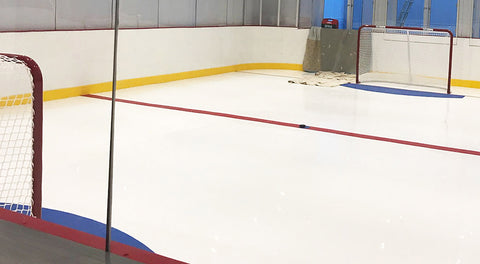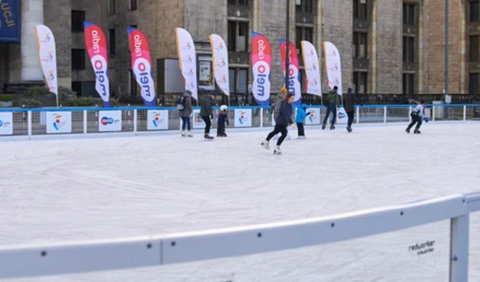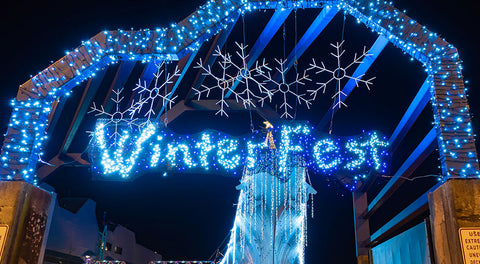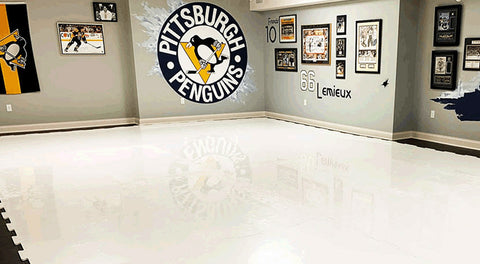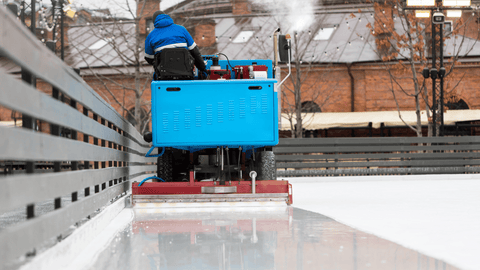With each passing year, the popularity of skating continues to soar.
With an increasing number of people looking for ways to stay fit and have fun, training at home has become more desirable.
In this article, we will cover the 10 best skating trainer tips to help you effectively train in the comfort of your own home and maximize your skating potential.
Skating is a versatile and engaging sport that requires a unique set of skills.
Learning how to train at home can be immensely beneficial, especially for those who may not have access to expert coaching or training facilities.
These tips will enable you to hone your skills and become a better skater, all without leaving your home turf.
Key Takeaways
- Mastering the fundamentals is crucial for effective home training
- Off-ice exercises and equipment can greatly enhance your skating abilities
- Maintaining a healthy lifestyle and incorporating breaks play a key role in skating progress
1. Understanding Skating Basics
Before diving into specific training tips, it's essential to have a solid grasp of the basic principles of skating.
As a beginner, you'll want to focus on developing foundational skills that will carry you through more advanced training.
Here are some key points to consider as you begin your journey in skating at home.
Proper Stance: Your posture and balance are crucial in skating.
Bend your knees slightly, lean forward a bit, and maintain a strong core.
Distribute your weight evenly across both feet to ensure steady and smooth movements.
Starting and Stopping: Learn to propel yourself forward by pushing off with one foot while gliding on the other.
To stop, turn your feet slightly inward in a "V" position and bend your knees.
Practice this on a flat surface before attempting inclines.
Turning and Edging: Be confident in turning in either direction.
To execute a simple turn, shift your body weight to the desired side while maintaining your balance.
Edging controls speed and provides more precise turns.
To edge, apply pressure to either the inner or outer portion of your skate wheels.
Cross Training: Participate in activities like yoga or strength training to build core, leg, and lower back muscles.
These complementary exercises will help improve your balance, posture, and overall performance on skates.
Remember, practice makes perfect.
Dedicate time daily to work on the basics, and keep in mind that progress may be slow at first.
As you continue your at-home training, these skills will become second nature, allowing you to move forward confidently toward more advanced techniques.

2. Key Skating Techniques
Mastering the Squat
The squat is a fundamental technique to master for your skating training.
Start by standing with your feet shoulder-width apart and your knees slightly bent.
Lower your body by bending your knees and pushing your hips back, keeping your chest lifted and your core engaged.
Aim to achieve a 90-degree angle with your knees while maintaining proper posture.
-
Low Stance: Practicing a low stance will improve stability and control in your movements.
-
Weight Distribution: Ensure equal weight distribution on both legs while squatting to maintain balance.
Skating Backwards
Skating backwards requires a comfortable grasp of balance and coordination.
To practice this technique, follow these steps:
- Align your feet in a V-shape, keeping your dominant foot slightly ahead.
- Apply pressure onto your toes and lift your heels to initiate the backward motion.
- Maintain your posture by keeping your knees slightly bent and your core engaged.
Remember to stay patient and practice regularly, as mastering the fakie could take time to achieve.
Mastering the Basic Skating Elements
Developing a repertoire of skating elements requires dedication and practice.
As you begin your training, focus on the following:
-
Start Small: Begin with basic moves, such as starts and stops, before progressing to more advanced moves.
-
Consistency: Repeat each skating element until you can execute it smoothly and confidently.
-
Safety Equipment: Wear proper protective gear, like a helmet and pads, when practicing skills to minimize the risk of injuries.
By following these guidelines and dedicating time to practice, you'll be well on your way to mastering key skating techniques at home.

3. Building Skating Skills and Confidence
To improve your skating skills and boost your confidence, consistent practice is essential.
Training at home allows you to work on your technique at your own pace, so take advantage of the opportunity.
The more time you dedicate to practice, the faster you'll see results.
Set realistic goals for yourself and focus on one skill at a time.
This will help you monitor your progress and stay motivated.
For example, concentrate on perfecting your balance before moving on to more advanced maneuvers.
Remember to celebrate your small wins, as they will encourage you to keep pushing forward.
Another way to build confidence is by practicing with friends.
Having supportive peers by your side can make the learning process more enjoyable and less intimidating.
Not only will friends offer constructive feedback, but it can also be more fun to try new tricks and techniques together.
Keep in mind that every skater's journey is unique; be patient with yourself and avoid comparing your progress to others.
It's essential to focus on your own growth and recognize that setbacks are natural.
With time and practice, your skills and confidence will undoubtedly improve.

4. Boosting Balance and Stability
When training at home, focusing on balance and stability is essential.
Concentrating on these aspects of your skating can lead to improved performance and reduced risk of injury.
Here are some tips to help you work on your balance and stability while practicing at home.
First, concentrate on your core muscles.
Your core plays a critical role in maintaining your balance.
Strengthening your core muscles can be achieved through exercises such as planks, bridges, and leg lifts.
Remember, a strong core leads to better overall stability on the ice.
Next, practice balance exercises off the ice to develop your skills.
One helpful exercise to try is standing on one leg with your eyes closed.
Hold this position for at least 30 seconds before switching to the other leg.
This will help you develop the balance and control you need during skating maneuvers.
When working on your balance, remember to maintain proper focus.
Develop a conscious awareness of your body's movement and positioning.
This means honing in on the aspects of each specific exercise or skating skill that you are working on.
By focusing on the details of your movement, you can improve stability.
Another key aspect of developing balance and stability is incorporating ankle exercises into your routine.
Building strength and flexibility in your ankles can help you maintain your balance while executing tight turns or jumps.
Try exercises such as seated ankle stretches and calf raises to increase your ankle strength.
Lastly, don't neglect the importance of proper equipment.
Using the right skate size and making sure your skates are laced up securely can make a significant difference in your balance and control on the ice.
Ensure your skate boots provide a snug fit and offer an adequate level of support for your feet and ankles.
Remember, by focusing on improving your balance and stability through core exercises, balance practice, focus, control, and the right equipment, you can enhance your at-home skating training for a more effective and enjoyable experience.

5. Strength Training for Skating
As a skater, you need to develop strength across various muscle groups.
Incorporating strength training into your home workout routine will help you improve your skating skills and prevent injuries.
This section focuses on core strength, lower body strength, and hip mobility exercises.
Core Strength Exercises
Your core provides stability and balance for your skating movements. Here are a few exercises to increase your core strength:
-
Planks: Hold your body in a straight line, with your forearms and toes on the ground. Aim for three sets of 30 seconds each.
-
Leg raises: Lie on your back and raise both legs straight up, engaging your core to prevent your lower back from arching. Perform 3 sets of 15 repetitions.
-
Russian twists: Sit on the floor with your knees bent and feet together, holding a dumbbell. Rotate your torso side-to-side, touching the dumbbell to the ground. Do 3 sets of 20 twists.
Lower Body Strength Exercises
Build lower body strength to increase your power and endurance during skating. Some exercises to try:
-
Squats: Stand with your feet shoulder-width apart and lower your body as if sitting on a chair. Keep your chest up and knees behind your toes. Do 3 sets of 15 repetitions.
-
Lunges: Step forward onto one foot, keeping your front knee behind your toes and lowering your back knee towards the ground. Push back to the starting position and repeat on the other side. Perform 3 sets of 10 repetitions per leg.
-
Calf raises: Stand on a step, letting your heels hang off the edge. Raise your heel, then lower it below the level of the step. Complete 3 sets of 20 repetitions.
Hip Mobility Exercises
Strengthening your hip muscles helps maintain stability and prevent injuries.
Here are some exercises to target your hips, quads, and glutes:
-
Hip bridges: Lie on your back, knees bent, and feet flat on the floor. Lift your hips while engaging your glutes, then lower back down. Perform 3 sets of 15 repetitions.
-
Side leg lifts: Lie on your side, supporting your head with your hand. Lift your top leg, keeping it straight and toes pointing forward. Complete 3 sets of 12 repetitions per side.
-
Clamshells: Lie on your side, with your knees bent and ankles together. Lift your top knee while keeping your feet touching. Do 3 sets of 12 repetitions on each side.
Incorporate these exercises into your at-home training routine to build your skating strength and enhance your performance on the ice.

6. Flexibility and Agility in Skating
Incorporating flexibility and agility exercises into your at-home skating training will greatly enhance your skating performance.
By improving your flexibility, you will increase the efficiency of your stride, allowing for better speed and control on the ice or pavement.
Agility drills will improve your ability to quickly change directions and make lateral movements with ease.
To improve your flexibility, make a habit of stretching regularly.
Focus on key muscle groups used in skating, such as your hip flexors, quadriceps, hamstrings, and calves.
Some effective stretches include lunges, hamstring stretches, and calf stretches.
Aim to hold each stretch for at least 30 seconds, taking deep breaths while maintaining the stretch position.
Agility is crucial in skating and can be enhanced through various drills.
One popular agility exercise is the lateral shuffle:
- Start by standing with your feet shoulder-width apart, knees slightly bent.
- Quickly shuffle to one side, then the other, maintaining a low stance.
This will help strengthen your lateral movement skills.
Another effective drill is the crossover step:
- Begin with your feet shoulder-width apart.
- Step your right foot over your left foot, then step your left foot to the side to regain the starting position.
- Repeat this exercise, alternating between right and left foot crossovers.
Incorporate jumping exercises to further boost your agility.
For Example:
- Perform lateral jumps over a small object to improve quickness and balance.
- You can also try single leg hops for added difficulty, which will simultaneously enhance your balance and stability on the ice.
Remember to start slow and gradually increase the difficulty and intensity of the agility drills.
This will help you properly train your muscles while reducing the risk of injury.
Through consistent practice of these flexibility and agility exercises, you will notice significant improvements in your skating abilities.

7. Off-Ice Training for Skating
Off-ice training is just as important as on-ice practice to improve your skating skills.
Incorporating a variety of exercises into your routine will help develop your strength, balance, and flexibility, leading to better overall performance.
Here are some tips to make your off-ice training just as effective as your time on the ice.
Lunges are a crucial exercise for skaters, as they target the muscles used in various skating moves.
Begin by standing tall with your feet shoulder-width apart.
Step forward with one foot and lower your body until your front knee is bent at a 90-degree angle.
Your back knee should not touch the ground.
Hold this lunge position for a few seconds before pushing back up and returning to the starting position.
Alternate legs and aim for 3 sets of 10-15 lunges on each side.
Balance exercises can be incorporated to sharpen your stability on the ice.
One simple method is to stand on one leg while lifting the other foot off the ground. Hold this position for 10-15 seconds before switching legs.
You can make this exercise more challenging by closing your eyes or standing on an unstable surface, such as a foam pad.
Core strength is essential for skaters to maintain proper posture and execute precise movements.
Strengthen your core muscles with exercises like planks, leg raises, and Russian twists.
Aim for 2-3 sets of each exercise, with 10-15 repetitions or holding planks for 30-60 seconds.
Flexibility is another key aspect of skating success, as it allows for a greater range of motion and smoother transitions between moves.
Incorporate various stretches into your off-ice routine, such as splits, hamstring stretches, and hip flexor stretches.
Focus on holding each stretch for 15-30 seconds, and repeat 2-3 times for each muscle group.
By incorporating these exercises into your off-ice training, you'll be well on your way to improving your skating skills and seeing progress on the ice.
Remember to stay consistent with your practice and keep challenging yourself with new techniques and exercises.

8. Useful Skating Equipment
To train effectively at home, it's essential to have the right skating equipment.
Here are some key items you'll need for a smooth and safe experience:
Inline Skates: Choose a reliable and durable pair of skates that meet your skill level and preferences.
Make sure the skate is fitted properly so you don't develop any blisters if there's too much play in the boot.
Protective gear: Safety is a priority when skating at home. Invest in high-quality protective gear such as a helmet, wrist guards, elbow pads, and knee pads.
These ensure your safety and minimize the risk of injury.
Skating surface: If you don't have access to the local rink, create a space customized for your training needs.
Synthetic ice is a great option for those with limited access to the rink and can be installed just about anywhere.
Slide Board: Slide boards are ideal for practicing and strengthening your legs and core muscles to become a stonger skater.
These are a great way to recreate the skating stride and motion without leaving home.
Maintenance tools: It's important to regularly maintain your skating equipment.
Make sure to clean and sharpen your skate blades regularly to ensure optimal performance.
With the right equipment and a dedicated training space, you can successfully practice and improve your skating skills at home in 2023.

9. Different Types of Skating
Skating is a versatile sport and can be practiced for various purposes, such as speed skating, hockey, and figure skating.
Each type of skating has its unique techniques and training methods.
In this section, we will discuss tips for each type of skating to help you train at home.
Tips for Speed Skating
Speed skating emphasizes velocity and endurance on ice or roller skates. To improve your speed skating skills at home, consider the following tips:
-
Strengthen your core: A strong core improves your balance and stability while skating. Incorporate planks, crunches, and Russian twists into your workout routine.
-
Work on your leg muscles: Strong legs generate power in each stride. Include squats, lunges, and leg presses in your exercise regimen.
-
Practice your technique: Focus on a proper skating form, with bent knees, a low body position, and efficient strides.
-
Increase your agility: Use off-ice exercises like ladder drills and jump rope to enhance your agility.
-
Consistent training: Create a schedule for regular at-home practice to maintain and enhance your skills.
Tips for Hockey Skating
Hockey players need excellent skating skills to maneuver and maintain stability throughout the game.
These tips will help you improve your hockey skating technique:
-
Edge control: Focus on inside and outside edge control by practicing drills like one-foot glides, crossovers, and tight turns.
-
Stride efficiency: A powerful stride will increase your speed on the ice. Work on extending your leg with each push and recovering it properly.
-
Stopping: Perfecting the hockey stop is crucial for quick changes in direction. Practice this technique by shifting your weight and rotating your feet.
-
Backward skating: Enhance your backward skating abilities with drills like backward crossovers and transitions.
-
Endurance: Cardio exercises like running or cycling will help you build the stamina required for a game.
Tips for Figure Skating
Figure skating combines artistic expression with intricate technical elements. Consider these tips to refine your figure skating skills at home:
-
Flexibility: Incorporate stretching exercises and yoga into your routine to improve your flexibility for jumps and spins.
-
Muscle strength: Strengthen your leg muscles with exercises like squats, lunges, and calf raises.
-
Balance: Practice single-leg stands as well as off-ice spinning to improve your balance.
-
Jumps: Develop your jump technique by practicing take-offs and landings on a flat surface with proper form.
-
Choreography: Dedicate time to create and refine your routines for a seamless and expressive performance.
By following these tips tailored for speed skating, hockey, and figure skating, you can effectively train at home and see improvements in your skating skills.

10. Incorporating Breaks and Maintaining Healthy Diet
Incorporating breaks into your home skating training routine is essential for your body's recovery.
Ensure that you're taking breaks when you feel tired or fatigued to prevent injuries.
These breaks allow your muscles to replenish nutrients, reduce lactic acid build-up, and prevent overexertion.
Breaks can range from a few minutes to a whole day off, depending on your training intensity and schedule.
A healthy diet plays a significant role in improving your endurance and overall performance in skating.
Pay attention to your daily intake of nutrients, focusing on a well-balanced diet.
Here are some key components to consider for maintaining a healthy diet:
-
Carbohydrates: Your primary source of energy. Aim to consume whole grains, fruits, and vegetables which provide a steady supply of energy for your training sessions.
-
Protein: Important for muscle recovery and growth. Include lean sources such as poultry, fish, beans, and low-fat dairy products in your meals.
-
Fats: Necessary for hormone production and the absorption of nutrients. Opt for healthy fats like avocados, olive oil, and nuts.
-
Hydration: Staying hydrated helps with muscle function and overall performance. Drink plenty of water before, during, and after your training sessions.
Incorporate these dietary tips into your daily routine to enhance your endurance and overall performance.
Remember that consistency is key, and by combining regular breaks with a healthy diet, you'll be well on your way to improving your skating skills at home.
Conclusion
By following these skating trainer tips, you can effectively train at home and improve your skating skills.
Remember to focus on the basics, such as posture and balance, to build a strong foundation for more advanced techniques.
Investing in quality equipment and setting up a dedicated practice area will ensure you have a safe and comfortable space to train.
Incorporate cross-training exercises into your routine to strengthen your muscles and increase your overall fitness level.
Stay patient and track your progress to keep yourself motivated and accountable.
Most importantly, don't forget to have fun and enjoy the process, as skating is not only a great workout but also an exciting and rewarding sport.
With consistent effort and dedication, you'll surely see improvements in your abilities and ultimately reach your skating goals.
